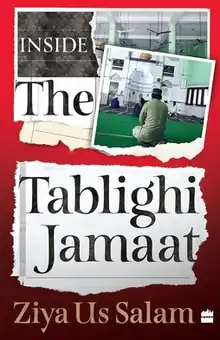 English cover | |
| Author | Ziya Us Salam |
|---|---|
| Country | India |
| Language | English |
| Subject | Tablighi Jamaat |
| Publisher | HarperCollins |
Publication date | 20 July 2020 |
| Pages | 260 |
| ISBN | 9789353579289 |
| OCLC | 1160025968 |
| Website | harpercollins.com |
Inside the Tablighi Jamaat is a book by Ziya Us Salam, a journalist at The Hindu. The book is an analysis of the Tablighi Jamaat from a critical standpoint.[1] Written after the controversy surrounding the Tablighi Jamaat COVID-19 hotspot in Delhi in 2020, it examines the group's history, practices, controversies, and internal dynamics. It highlights the mission, organizational structure, and impact of the Tablighi Jamaat on the Muslim community and presents insights into the Tablighi Jamaat's philosophy, its approach to spreading Islamic teachings, and its influence worldwide.
Thematic overview
The book comprises twenty-four chapters and 260 pages. It describes the history of Tablighi Jamaat, founded in 1927 by Ilyas Kandhlawi with a mission to enhance Muslims' internal spirituality. Despite its non-political stance, the organization survived unscathed during Indira Gandhi's Emergency,[2] maintaining a global presence in nearly 150 countries.[3] However, it faces a ban in Saudi Arabia due to controversial literature. The revered Fazail-e-Amaal book focuses on anecdotes rather than Quranic teachings, emphasizing five daily prayers but avoiding in-depth discussions on the Quran.[3] While promoting religious identity, Tablighi Jamaat discourages women's mosque attendance. The organisation was criticized for not canceling events during the COVID-19 pandemic, and internal conflicts had led to a 2017 split between the current head, Saad Kandhlawi, and his opponents. The split extended to Bangladesh and Pakistan. Legal issues persist in Central Asia, and the organization's leadership remains within Ilyas Kandhlawi's family.[4]
Spiritual and ritualistic, Tablighi Jamaat avoids engagement with worldly matters and major Islamic issues, including Triple talaq.[5] Isolationist, the organization refrains from interacting with non-Muslims and avoids conversion efforts.[6] Technology-averse, it operates with foot soldiers rather than card-holding cadres, influencing mosques globally. Women are viewed as appendages, with limited roles in public religious activities. Life is perceived as a journey of internal cleansing for members, impacting the identity of poor Muslims. Post-Covid changes are deemed unlikely, and Saudi Arabia maintains a disdainful view.[4] The organization, along with the internet, contributes to the democratization of Islam but faces criticism for not emphasizing Quranic liberalism.[3]
The book notes mediators like Ulama in Islam, highlighting the contrast between Quranic liberalism and scholarly orthodoxy. Many Islamic movements seek a return to the purity of early Islam, grappling with the liberalism of the Quran and the rigidity of scholars. Faith and rationalization tensions persist, prompting a call for reform and modernization in Islam across various shades. Anxieties in practicing Muslims, praying correctly, the risk of non-acceptance, and the importance of good deeds are explored. Hadith often takes precedence over the Quran, emphasizing emulation of the Prophet's life. Few Muslims read the Quran, preferring Arabic recitation. Islam is seen independently of practitioners, leading to disagreements. There is general agreement on the need for Muslim reform, and the role of religion is acknowledged for providing meaning rather than rational explanation.[3]
Press reviews
The book received mixed reviews from diverse perspectives. Telangana Today praises it as a seminal study but notes a predominant critical stance.[4] Muslim Mirror criticizes certain aspects, highlighting potential influences from social media and bias in comparison with other Muslim organizations.[1] Outlook regards the book as a crucial intervention in understanding the historical continuity of the Tablighi Jamaat amid recent controversies.[7] Hindustan Times finds it remarkable that the author managed to complete the book so promptly without compromising on quality, praising his grasp of the psychology behind the movement and the lucidity of his writing.[3]
See also
References
- 1 2 Ashfaq, Farkhanda (8 September 2020). "Book Review: Inside the Tablighi Jamaat by Ziya Us Salam". Muslim Mirror. Archived from the original on 12 November 2023. Retrieved 17 December 2023.
- ↑ Roychowdhury, Adrija (22 July 2020). "Important for Tablighi Jamaat to speak on issues of Islamic interests: Author of new book". The Indian Express. Archived from the original on 12 November 2023. Retrieved 17 December 2023.
- 1 2 3 4 5 Farooqui, Mahmood (20 July 2020). "Review: Inside the Tablighi Jamaat by Ziya Us Salam". Hindustan Times. Archived from the original on 12 November 2023. Retrieved 17 December 2023.
- 1 2 3 "Demystifying Tablighi Jamaat". Telangana Today. 1 June 2021. Archived from the original on 2 December 2022. Retrieved 17 December 2023.
- ↑ D Lone, Mehraj (5 August 2020). "NL Conversation: Ziya Us Salam on the vilification of the Tablighi Jamaat, its apolitical stance, and his latest book". Newslaundry. Archived from the original on 12 November 2023. Retrieved 17 December 2023.
- ↑ Agrawal, Aarushi (21 July 2020). "Books of the week: From Perumal Murugan's Estuary to Mary L Trump's Too Much and Never Enough, our picks". Firstpost. Archived from the original on 19 November 2023. Retrieved 17 December 2023.
- ↑ Qaiser, Rizwan (29 September 2020). "Inside The Tablighi Jamaat: A Book Review". Outlook. Archived from the original on 12 November 2023. Retrieved 17 December 2023.